If you’ve ever savored a slice of Italian sponge cake, you know it’s a delightful blend of lightness and flavor. This classic dessert, known as “Pan di Spagna” in Italy, has a rich history dating back to the Renaissance. It’s the perfect base for countless desserts, from layered cakes to simple, elegant treats topped with fresh fruit and a dusting of powdered sugar.
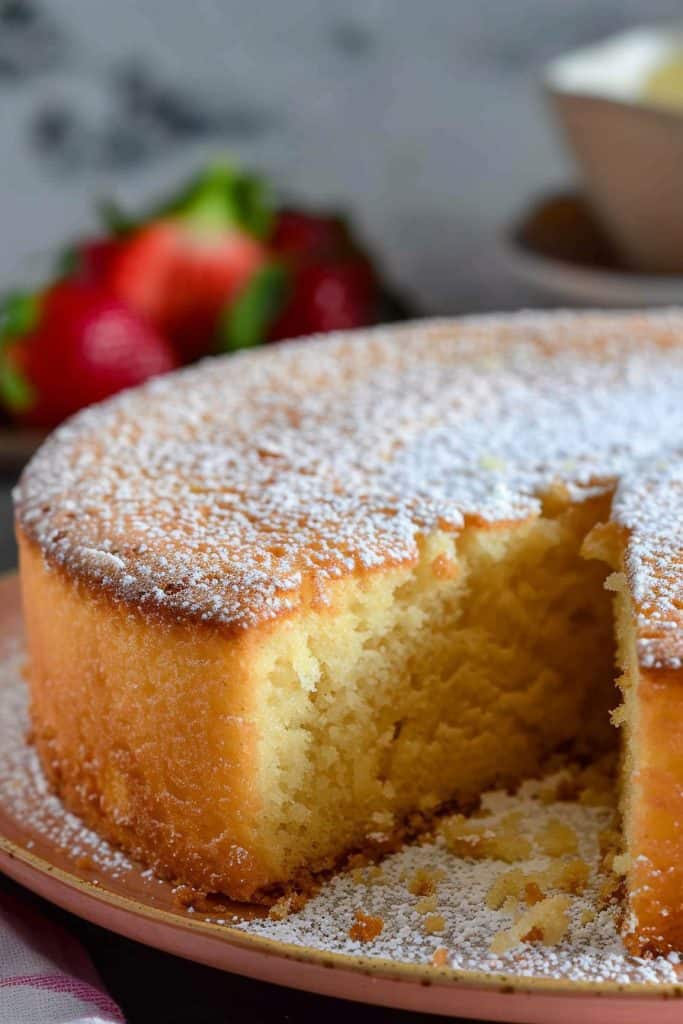
Ingredients
To create the classic Pan di Spagna, you’ll need the following ingredients. Ensure they are prepared as noted for the best results:
- 5 large eggs, separated
- 1 cup (200g) granulated sugar
- 1 cup (125g) all-purpose flour, sifted
- 1 teaspoon vanilla extract
- 1/4 teaspoon salt
- Preheat your oven to 350°F (175°C). Grease and flour an 8-inch round cake pan to prevent sticking.
- In a large mixing bowl, beat the egg yolks with the granulated sugar until the mixture becomes thick and pale. This process should take about 5 minutes.
- Add the vanilla extract to the egg yolk mixture and stir to combine.
- In a separate bowl, whisk the egg whites with salt until they form stiff peaks. Be careful not to overbeat.
- Gently fold the sifted flour into the egg yolk mixture in small increments. Use a spatula to fold carefully, ensuring you don’t deflate the mixture.
- Gradually fold the beaten egg whites into the batter. Mix slowly to maintain the light, airy texture.
- Pour the batter into the prepared cake pan, leveling the top with a spatula.
- Bake in the preheated oven for 25-30 minutes or until a toothpick inserted into the center comes out clean.
- Allow the cake to cool in the pan for 10 minutes before transferring to a wire rack to cool completely.
Equipment
To achieve the perfect Italian sponge cake, having the right equipment is crucial. Here is a list of the essential tools you will need:
- Mixing Bowls: I use two large mixing bowls, one for the egg yolks and one for the egg whites. It’s essential to have clean and dry bowls for the egg whites to whip properly.
- Hand Mixer or Stand Mixer: A powerful hand mixer or stand mixer ensures that you can beat the eggs and sugar until they reach the desired volume and consistency. Consistent mixing is key to a light and airy sponge.
- Sifter: A sifter is necessary to aerate the flour before folding it into the batter. This step helps to avoid lumps and ensures a smooth, light texture.
- Spatula: A rubber spatula is perfect for gently folding the sifted flour and beaten egg whites into the batter without deflating it.
- 9-Inch Springform Pan: A 9-inch springform pan works best for this recipe. Its removable sides make it easier to release the delicate sponge cake without damaging it.
- Parchment Paper: Lining the bottom of the pan with parchment paper prevents the cake from sticking and ensures a clean release.
- Cooling Rack: Using a cooling rack allows the cake to cool evenly and prevents it from becoming soggy.
Having these tools on hand will make the process of baking an Italian sponge cake smooth and enjoyable. Each piece of equipment plays a vital role in ensuring that the cake is light, airy, and evenly baked.

Directions
Prep
- Preheat the Oven: Begin by preheating your oven to 350°F. Ensure it reaches a stable temperature before you start baking.
- Prepare the Pan: Line the bottom of a 9-inch springform pan with parchment paper. Lightly grease the sides with butter and dust with flour.
- Sift the Dry Ingredients: In a large bowl, sift together 1 cup of all-purpose flour and 1 teaspoon of baking powder. This step ensures that your batter remains light and free from lumps.
- Separate the Eggs: Separate 4 large eggs, placing the yolks in one bowl and the whites in another. Make sure no yolk contaminates the whites to ensure they whip properly.
- Beat the Yolks: Using a hand mixer or stand mixer, beat the egg yolks with 1 cup of granulated sugar at medium-high speed until thick, pale, and ribbon-like. This takes about 5 minutes.
- Incorporate the Dry Ingredients: Gradually add the sifted dry ingredients to the yolk mixture, gently folding with a spatula until well combined.
- Whisk the Egg Whites: In a clean mixing bowl, beat the egg whites with a pinch of salt on medium speed until soft peaks form. Gradually add another 1/4 cup of sugar and continue beating until stiff, glossy peaks form.
- Fold the Egg Whites: Gently fold the egg whites into the yolk mixture in three parts, taking care not to deflate the batter. Use a spatula and a light hand to maintain the airy texture.
- Pour the Batter: Pour the batter into the prepared springform pan, smoothing the top with a spatula to ensure even baking.
- Bake the Cake: Place the pan in the preheated oven and bake for 25-30 minutes, or until the cake is golden brown and a toothpick inserted into the center comes out clean.
- Cool the Cake: Remove the cake from the oven and let it cool in the pan for 10 minutes. Then, run a knife around the edge, release the springform pan sides, and transfer the cake to a cooling rack to cool completely.
- Serve: Once fully cooled, the Italian sponge cake is ready to be layered, frosted, or served as desired. Enjoy the light and airy texture with your favorite toppings or fillings.
Tips for Making the Best Italian Sponge Cake
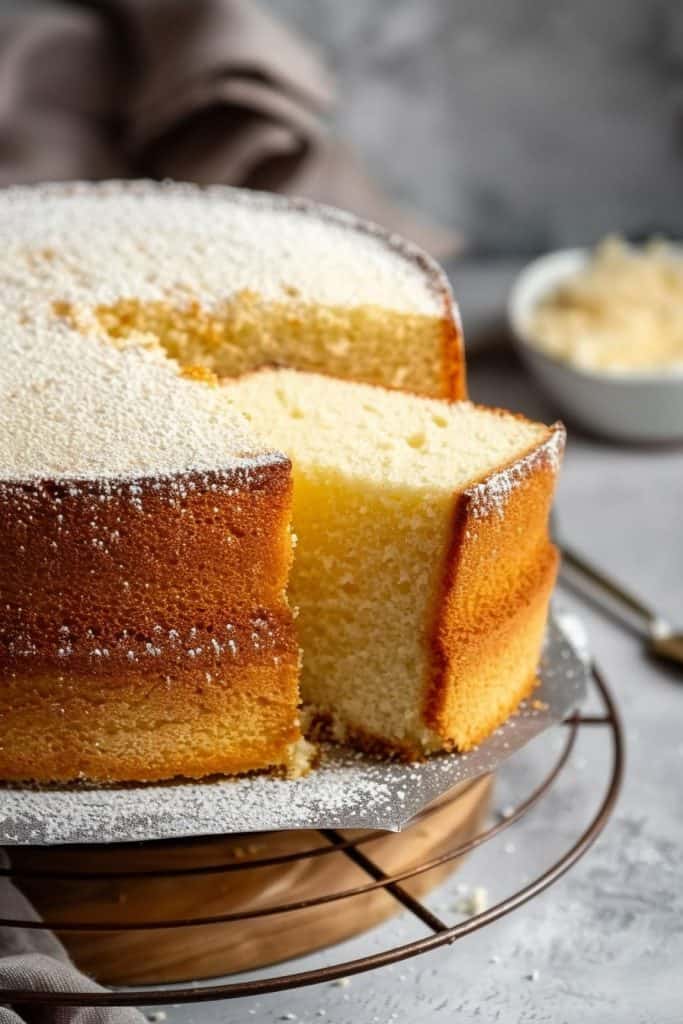
Use Room Temperature Ingredients
Ensure all your ingredients are at room temperature before you start. This includes eggs, milk, and butter. Room temperature ingredients mix more evenly, resulting in a smoother batter and a more consistent bake. I always take my eggs and butter out of the fridge at least an hour before baking.
Properly Separate Eggs
When separating eggs, make sure there is absolutely no yolk in the whites. Any trace of fat can prevent the egg whites from whipping to their full volume. I recommend using the three-bowl method: one bowl for the whites, one for the yolks, and one to separate each egg individually before adding it to the main bowls.
Whip Egg Whites to Stiff Peaks
Whipping the egg whites to stiff peaks is crucial for the airy texture of the sponge cake. Use a clean, dry bowl and whisk or mixer attachment. Start on a low speed and gradually increase to high. You’ll know you’ve reached stiff peaks when the whites stand up straight and don’t fold over when you lift the whisk.
Fold Gently
When incorporating the whipped egg whites into the batter, do so gently to retain the air and volume you’ve created. Use a spatula to fold the mixture, making sweeping motions from the bottom of the bowl to the top. Overmixing will deflate the batter and result in a denser cake.
Sift Dry Ingredients
To prevent lumps and ensure a light, even texture, always sift your flour and other dry ingredients before folding them into the batter. Sifting helps to aerate the flour, making it easier to mix into the rest of the ingredients without overworking the batter.
Preheat and Prepare Your Oven
Always preheat your oven to the exact temperature needed before placing the cake inside. An inaccurate oven temperature can affect the cake’s rise and texture. Additionally, ensure that your oven racks are positioned in the center to allow for even baking.
Avoid Overbaking
Italian sponge cake should be golden brown and spring back when lightly pressed in the center. An overbaked cake will be dry and crumbly. Start checking for doneness a few minutes before the suggested baking time ends by inserting a toothpick into the center. It should come out clean or with a few moist crumbs clinging to it.
Cool Properly
Once the cake is done, let it cool completely in the pan on a wire rack before removing it. This helps the cake to set and prevents it from breaking apart. If your cake sticks to the sides of the pan, run a sharp knife around the edges before turning it out.
By following these tips, you’ll be on your way to creating a flawless Italian sponge cake every time.
How to Know When Sponge Cake Batter Reaches Ribbon Stage
Achieving the ribbon stage is crucial for a perfect Italian sponge cake. Here’s how I determine when the batter is just right:
- Whisk Until Pale and Thick: First, in a large mixing bowl, I whisk the eggs and sugar together on medium-high speed. This step is essential for incorporating air. I continue whisking until the mixture turns pale and thickens significantly. This usually takes about 8-10 minutes.
- Check for Consistency: To test the consistency, I lift the whisk or beaters out of the bowl. The batter should fall back in thick ribbons that hold their shape on the surface for a few seconds before disappearing. This indicates that the eggs have incorporated enough air, giving the batter a light, airy quality.
- Use the ‘Figure 8’ Test: Another method I use is drawing a figure 8 with the batter that drips from the whisk. If the 8 holds its shape briefly before sinking back into the batter, I know it’s at the ribbon stage. This simple test helps ensure the right texture for baking.
- Observe the Glossiness: Finally, I look for a glossy finish on the batter. A silky, shiny surface suggests the sugar is well incorporated, and the batter has the correct viscosity.
These steps help me consistently achieve the perfect ribbon stage, ensuring my Italian sponge cake comes out light and airy every time.
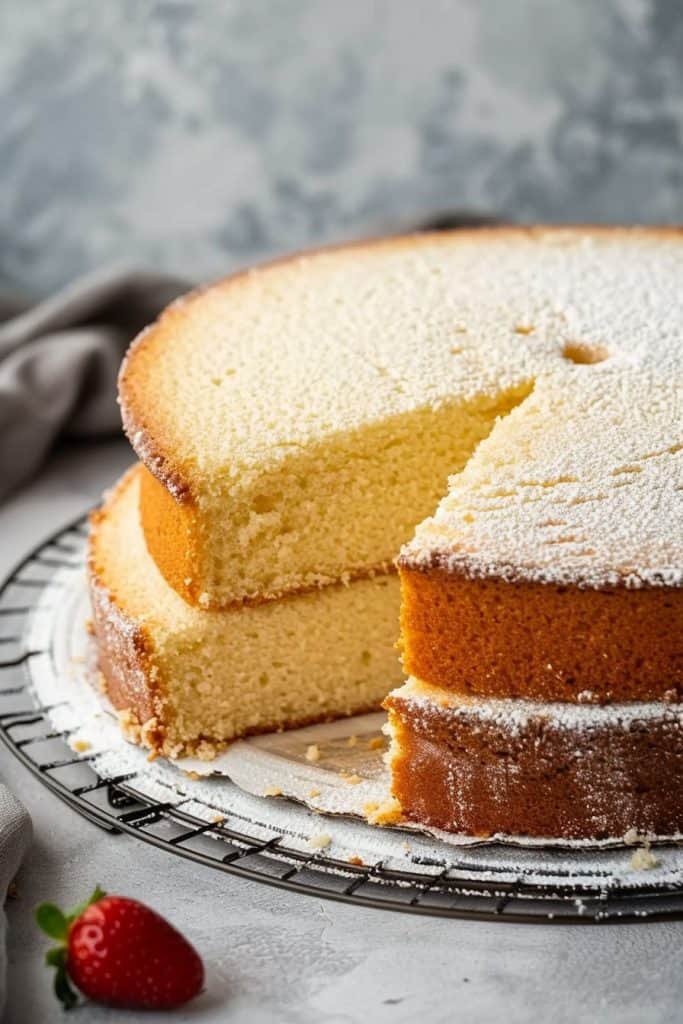
Serving Suggestions
When it comes to serving Italian sponge cake, the possibilities are endless. Here are a few of my favorite ways to enjoy this versatile dessert:
Simple and Elegant
- Sprinkle Powdered Sugar: Lightly dust the top of the cake with powdered sugar for a simple, elegant presentation.
- Fresh Berries and Cream: Serve with a side of fresh berries such as strawberries, raspberries, or blueberries. Add a dollop of freshly whipped cream for a classic touch.
Filled and Frosted
- Layered with Pastry Cream: Slice the sponge cake into layers and fill with rich, vanilla pastry cream. You can also add fresh fruit between the layers for added texture and flavor.
- Italian Buttercream Frosting: Frost the cake with a smooth and silky Italian buttercream for a luxurious finish. Try incorporating flavors like coffee, vanilla, or lemon.
Decadent Treats
- Chocolate Ganache Drizzle: Drizzle warm chocolate ganache over the top of the cake. Let it cascade down the sides for a visually stunning effect.
- Tiramisu-Inspired Layers: Transform your sponge cake into a tiramisu by soaking the layers in espresso and layering with mascarpone filling. Dust the top with cocoa powder.
Festive Options
- Fruit Glaze: Create a glaze using your favorite fruit jam or preserve. Heat until smooth, then pour over the cake for a shiny, flavorful topping.
- Holiday Decorations: Decorate with seasonal fruits and edible flowers for a festive look. Try using pomegranate seeds and mint leaves for a holiday touch.
- Mini Cakes: Use a cookie cutter to create mini sponge cakes. Serve individually with personalized decorations.
- Cake Parfaits: Layer sponge cake pieces in a glass with custard, fruit, and whipped cream to create beautiful and easy-to-serve parfaits.
These serving suggestions not only elevate the presentation of the Italian sponge cake but also enhance its flavor and texture, making each bite a delightful experience.
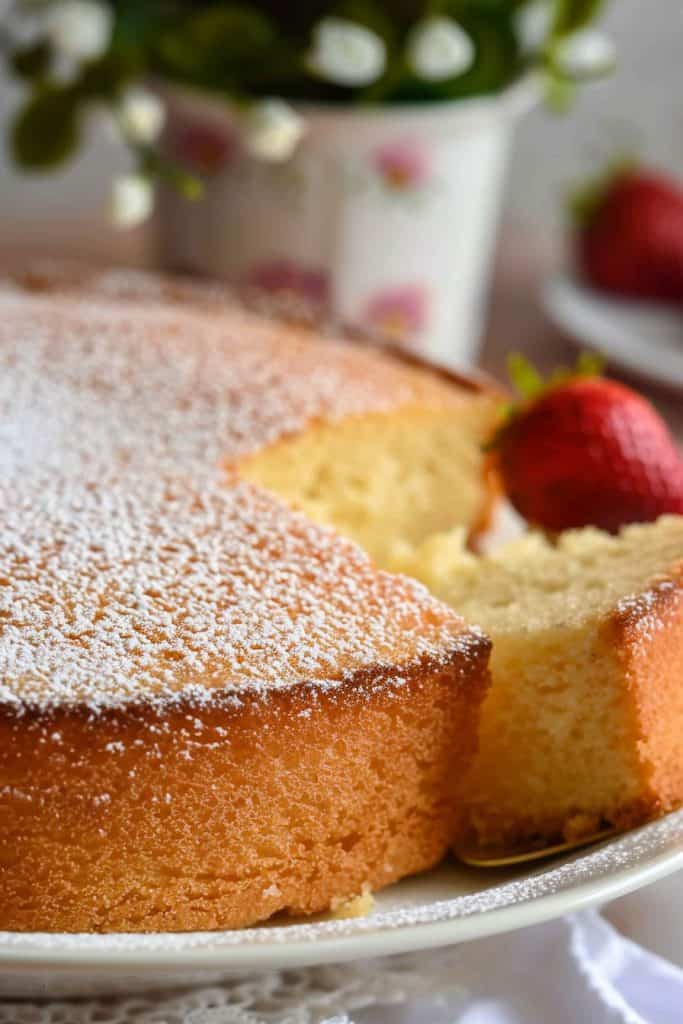
How to Store
Room Temperature
To store your Italian sponge cake at room temperature, follow these simple steps:
- Allow to Cool: Let the sponge cake cool completely on a wire rack to prevent condensation.
- Wrap Properly: Wrap the cooled cake tightly in plastic wrap to keep it moist and prevent it from drying out.
- Use Airtight Container: Place the wrapped cake in an airtight container. It can stay fresh for up to 2 days.
Refrigeration
For longer storage, the refrigerator is a better option:
- Cool Completely: Ensure the sponge cake is fully cooled to prevent sweating and sogginess.
- Wrap and Seal: Wrap the cake in plastic wrap tightly and then in aluminum foil to double-seal it.
- Refrigerate: Store the wrapped cake in the refrigerator. It can last up to a week.
Freezing
If you need to keep the cake for an extended period, freezing it is the best method:
- Prep the Cake: Allow the cake to cool completely before wrapping.
- Double Wrap: Wrap each cake layer individually in plastic wrap and then in aluminum foil.
- Label: Label the packages with the freezing date.
- Freeze: Place the wrapped cakes flat in the freezer. They can be stored for up to 3 months.
- Thawing: Thaw in the refrigerator overnight before using. Allow it to come to room temperature before serving.
By following these storage methods, you can ensure the Italian sponge cake stays fresh and delicious whenever you are ready to serve it.
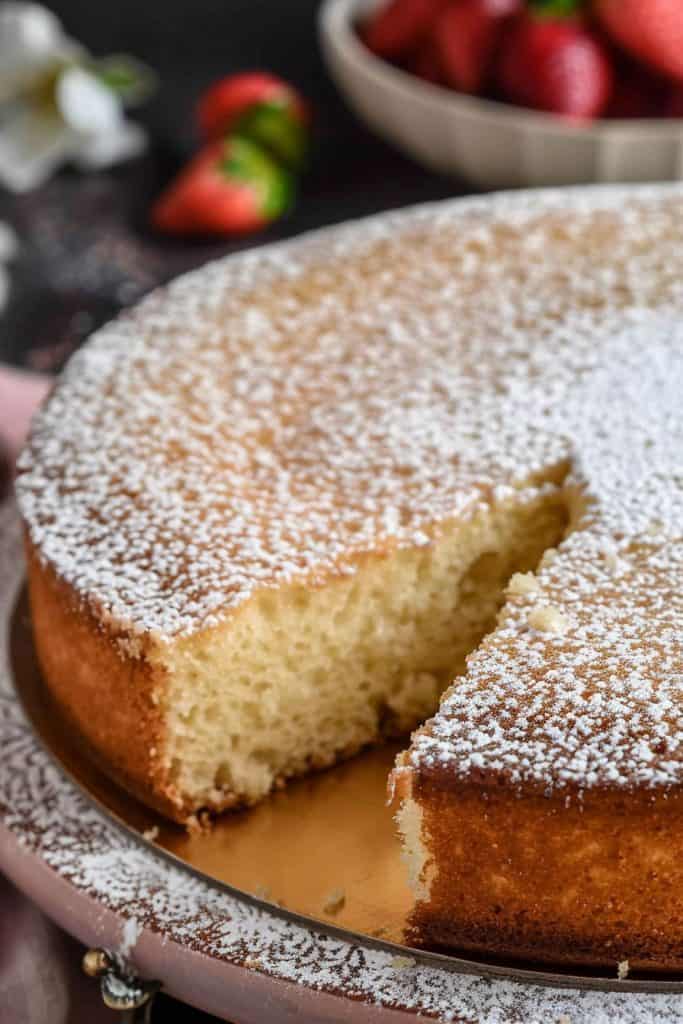
Variations and Substitutions
When making Italian sponge cake, there are several variations and substitutions to customize the recipe to your taste or dietary needs. Here are some popular ones:
Flavor Variations
- Lemon Zest and Almond:
- Add 1 tablespoon of lemon zest and substitute 1/4 cup of the flour with finely ground almonds.
- Mix the dry ingredients with the ground almonds before folding them into the egg mixture.
- The lemon zest enhances the flavor, and ground almonds add a delightful nutty texture.
- Chocolate:
- Sift 1/4 cup of unsweetened cocoa powder with the flour.
- Gently fold the cocoa-flour mixture into the egg mixture.
- This substitution gives the cake a rich, chocolatey note, perfect for chocolate lovers.
- Vanilla and Orange:
- Add 2 teaspoons of vanilla extract and 1 tablespoon of orange zest to the egg mixture.
- The combination of vanilla and orange adds a fragrant touch and a slight citrus twist to the cake.
Dietary Substitutions
- Gluten-Free:
- Replace all-purpose flour with a gluten-free flour blend in a 1:1 ratio.
- Ensure the gluten-free flour blend includes xanthan gum for structure, or add 1/4 teaspoon of xanthan gum to the mix.
- This substitution allows those with gluten sensitivities to enjoy a delicious sponge cake.
- Sugar-Free:
- Substitute granulated sugar with a sugar-free sweetener such as erythritol or stevia in a 1:1 ratio.
- Ensure the sweetener used is suitable for baking to avoid compromising the cake’s texture.
- This makes the cake diabetic-friendly without sacrificing sweetness.
- Dairy-Free:
- If the recipe calls for any dairy, substitute with plant-based alternatives like almond milk or coconut milk in a 1:1 ratio.
- Use coconut cream for any cream requirements.
- This adaptation makes the cake suitable for those who are lactose intolerant or vegan.
- Moisture Boost:
- Add 1/4 cup of Greek yogurt to the batter for extra moisture.
- Fold the Greek yogurt gently into the egg mixture before adding the flour.
- This will yield a moister, richer sponge cake.
- Richer Cake:
- Substitute half of the granulated sugar with brown sugar.
- The brown sugar adds a deeper flavor and slightly denser texture.
Experimenting with these variations and substitutions can tailor the Italian sponge cake to fit your preferences or dietary restrictions without sacrificing its delightful taste and texture.
Conclusion
Exploring the world of Italian sponge cake recipes has been a delightful journey. From understanding the traditional Pan di Spagna to experimenting with various flavors and dietary substitutions, there’s something for everyone. Whether you’re a fan of classic lemon zest or need a gluten-free option, these recipes offer endless possibilities. By following the tips and techniques shared, you can create a cake that’s not only delicious but also tailored to your unique preferences. Don’t forget to store your cake properly to keep it fresh and ready to impress at any occasion. Happy baking!
